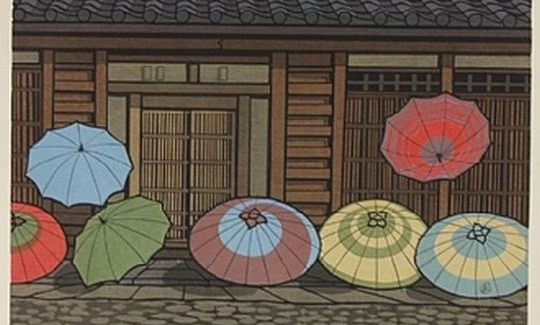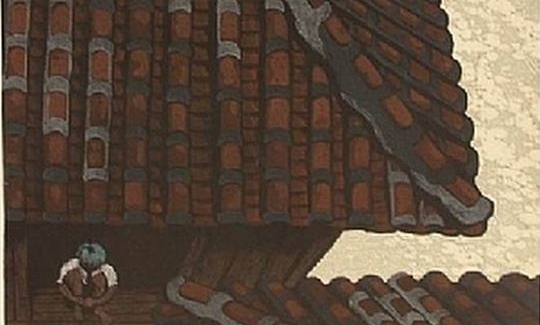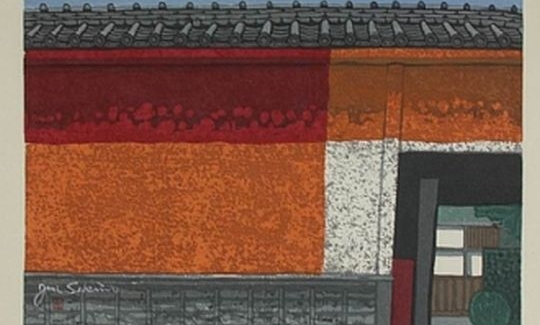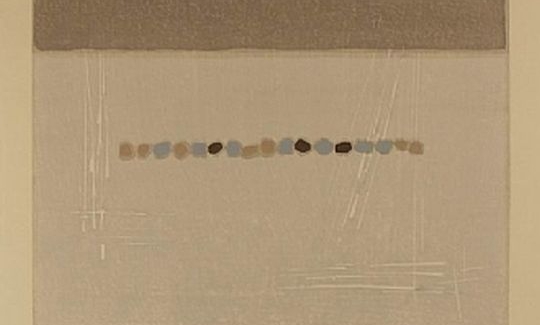This exhibition deals with the boundary between realistic and abstract art in modern Japanese prints. While realistic art presents scenes identifiable to any viewer, in abstract art the eye is frequently unable to discern anything familiar, from nature or from our environment. In Japanese art that represents a transition between these two modes, one can easily identify the subject of a painting, though the artists' aim is not necessarily to reproduce reality. They aspire to harmonious compositions of geometrical elements, lines and patches of colour on a flat surface. In Japanese prints this is evident in such motifs as the facades of buildings, or gardens that are still recognizable, but which have undergone specialized artistic treatment. If, for instance, there is an architectonic element in the foreground of a picture, leaving almost no space for background, identification of the foreground of the print as that of the building is created. As regards colour, defined pastel areas are integrated and intermingled, or achieved by means of a restrained tonality. This can be clearly seen in the woodblock print Kameyama, Tokaido by Sekino Junichiro, and in the etching Northern City 5 by Kitagawa Yoshie. In both works it seems that the artists' efforts concentrated on the flatness of the paper, rather than on the three-dimensional buildings they were depicting.
Tiled roofs or those of temples are another dominant element in Japanese prints, in which the whole surface - or most of it - shows a portion of a tiled roof, creating an endless, rippling rhythm. This can be seen in Rain at Yonakuni by Ono Mitsuhira, Chinese Temple by Sekino Junichiro, Setoichi in Sunshine by Shimayoma Tsutomo, and in Rear View of Nijo Castle by Hashimoto Okie. Like the traditional Japanese prints, especially those of Ando Hiroshige (1797-1858), these elements are cut, and the composition is perfect even without obeying the laws of perspective of European Renaissance art. In depictions of exteriors or the facades of buildings, emphasis is on the decorative aspects of walls and roofs, represented by means of areas of colour, parallel lines, diagonals and triangles, all creating a sense of order and style. A composition of parallel lines can be seen in Drying Ground for Squid, and the triangular construction is evident in Shirakawa-go in Snow, both by Kitaoka Fumio. Maeda Masao's print Stone Garden at Ryoanji Temple A is based on diagonals.
One of the dominant elements in modern Japanese prints is a sense of isolation, of alienation, which may be characteristic of modern life even for the artist. Most of the works are devoid of human beings, but if they are depicted, they have become absorbed into the natural or urban landscape. Modern man has left his mark on the landscape in the form of television antennae, electricity posts and cables, and other such objects and constructions. These are the only elements that bear witness to man's presence in a semi-abstract composition. This can be seen in the prints Setoichi in Sunshine by Shimoyama Tsutomo, and Diary, June 12th (Street) by Noda Tetsuya, which depicts the facades of buildings as seen from a moving vehicle, and conveys a sense of the speed at which life passes by. Although this sense of the ephemeral is a melancholy element, the movement also expresses a measure of vitality.
The artists have chosen not to reject familiar scenes in their works, not to concentrate on pure abstraction, suggesting that traditional Japanese art has not been ousted by the new, and that modern art is, in fact, a synthesis of tradition and foreign influences. Thus, for instance, the artists attach great importance to relating to the concept of space in their works. In traditional Japanese art, the empty space played a major role, and artists related to it as being at least as important as the content of a picture. By means of a few lines or splashes on a blank surface, the artist could convey an entire universe. The empty space in their works becomes, in effect, an entity, and the object in the work is no longer "something" resting on "nothing". The equilibrium of space and object is not achieved by symmetrical division of the surface, but by the relationship of the object in the work to its "weight" in the space. This can be clearly seen in Horizon and Form and in Sky and Stones, both by Yamanaka Gen, and also in Stone Garden at Ryoanji Temple by Maeda Masao, and Stone and Sand Garden C by Hashimoto Okie. The artistic abstraction and aesthetic values such as minimalism and symbolism that are apparent in the works of these artists are deeply rooted in traditional Japanese art, in the Noh Theatre that began in the 14th century, and in the ink drawings consisting of a few brush-strokes on an empty space by the Zen monks. That this aesthetic is still conspicuous in modern Japanese works is evidence of the integration of abstract art with the artistic traditions of the past.
Many of the works exhibited are by artists who belonged to the avant-garde Sosaku Hanga (Creative Prints) Movement that was started in the first decade of the 20th century and their successors. Members of this Movement believe that the artist himself must undertake all the processes endemic to print-making - preparatory sketches, carving the block, and the actual printing. For the traditional woodblock prints each process required a different artist. Other printing techniques, such as lithography, silk-screen, engraving, etching - all of them international modes of expression - and other media, are indicative of the artists' desire to depict universal subjects with their own personal vision.
The modern Japanese artists whose works appear in the exhibition have been exposed to the artistic spirit and trends of the West. Here we can see traces of the influence of Monet, Seurat and Mondrian, but there can be little doubt that the strongest influence is still that of traditional Japanese art. Though the subjects of the works may be traditional, the lyrical portrayals characteristic of the old masters are gone. Nonetheless, all these artists have one common aim: absolute mastery of the various printing techniques, and the highest standards of expression. Integrity and accomplishment are certainly the outstanding qualities of the heritage of Japanese art.




